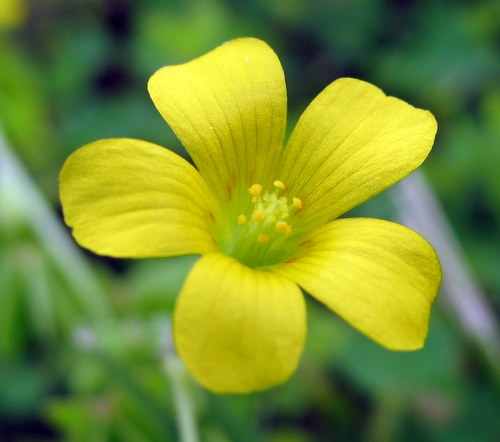Flower ID challenge
Eric correctly identified the previous challenge photo as Black Medic–a small plant of lawns. It’s been reported that Black Medic seeds were a special delicacy in ancient Rome. It’d take a lot time to collect enough to make even one serving. Now for an new challenge–maybe easier–maybe harder. Try and identify this common flower:


Scott is correct–it is the yellow wood sorrel. I’ll see about more challenges next week….
BW
I believe that this flower is a Yellow Wood Sorrel. This picture really captures the essence of what I try to do in teaching biology: attempt to convey to others the beauty that I see in the natural world. I think that when students leave my class, this is the single most important trait they could take with them. If students leave my class with nothing more than a deeper appreciation of the beauty and the mystery that underlies all life on our planet, I will have done my job. I think that photography such as this, along with loads of outdoor experiences, can go a long way in fostering those notions in our students; at least I hope that’s the case. I look forward to dialoguing with fellow KABT’ers in the future on ways to better help my students see the beauty and mystery that make the lifelong pursuit of biological understanding such a rewarding experience.
Me thinks that this species would actually fit in two of Linneaus’ classes: First of all, I think it is described by the term: pentadecandria (10 stamens, 5 tall and 5 short) but the base of these stamens is also united so that would also mean we need to consider the plant to be monadelphia according to these principles of classification.
BTW, since we are talking about historical figures–other plants in the group actually have flowers that vary the lengths of styles and stamens–some flowers having long stamens/short styles and others having opposite–a dimorphism. Others in the group are tri-morphic. Presumably, this arrangement promotes cross-fertilization and limits self-pollination. According to William Chase Stevens, Darwin carried out experiments to try and determine the potential benefit of this polymorphism (trimorphism). Stevens also quotes Darwin–but that would take more space and require some diagramming to adequately describe Darwin’s investigation…..Nice work, Eric.
Scott Sharp has directly emailed a possibility–maybe he’ll post soon.
This is a beautiful flower that is unknown to me, and I am not picking up my field guide as quickly this time. I sit back and learn.
If I may add something though. This past year was the anniversary of Carl Linneaus’ 300th BD. While trying to win a trip to Sweden with my environmental club (we didn’t win), I became interested in Linneaus’ actual work. Here is a link to a draft document that I cut and paste from a variety of sources introducing his system for classifying plants.
http://www.bv229.k12.ks.us/biophilia/LinneanPlantClassification.doc
At the time it was scandolous yet popular (and easy to use) for it use of terminology that humans could so aptly relate to being, as they say, semi-permiscuous.
So, after you have identified the Brad’s challenging flower, I subsequently challenge you to honor Carl’s belated BD by classifying the same flower using this elegant though un-natural system of classfication.
And if you would like to work on an activity that could be done with the system using wildflowers that can be easily found at the beginning of school, I think that would be enjoyable.